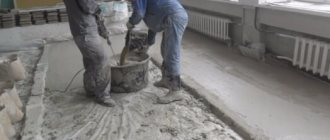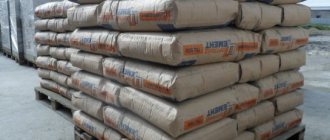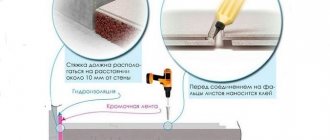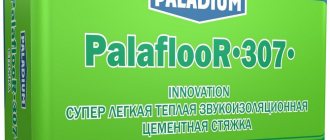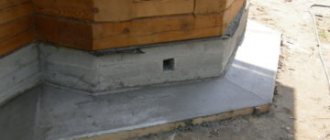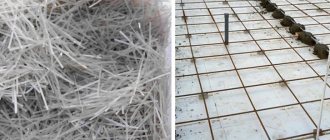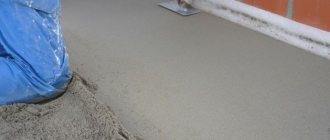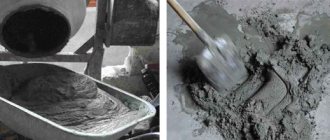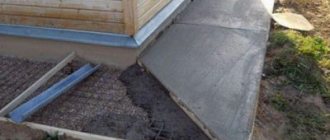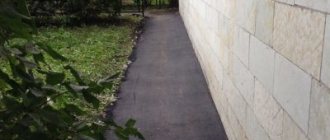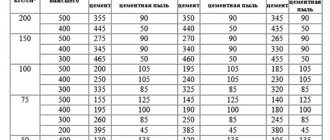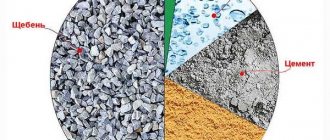The reason for the unconditional popularity of porous granules made of baked clay is that at low cost this material not only improves the thermal properties of the base, but also makes it possible to significantly increase the level of its surface. At the same time, floor screed with expanded clay can be performed in several ways - their technological features will be discussed in this article.
One of the leveling methods does not involve wet processes
Expanded clay concrete screed: what is it and when should it be used
Expanded clay concrete is the so-called lightweight concrete, in which expanded clay is used as a filler. It is usually used where the screed layer is large. This means that the load on the floor will be significant. Expanded clay is a lightweight aggregate and concrete with such aggregate has less mass. But it is worth considering that a screed made of expanded clay concrete makes sense with a thickness of 6 cm or more. Then the difference in weight will be about 40-60 kg per square meter. The greater the thickness, the greater the weight gain. Disadvantages of expanded clay concrete:
- The price of expanded clay concrete compared to cement-sand screed (CSS) is approximately 30% higher.
- It is more difficult to manufacture.
- More problematic during installation.
And that is not all. You will not get a perfectly flat surface. Under tiles it will be fine, but under linoleum, laminate and other coatings, a leveling screed will be needed on top. This is additional time, and this must also be taken into account when calculating the thickness of the expanded clay concrete layer.
On top of expanded clay concrete, under many floor coverings, it will be necessary to pour a leveling layer
What is expanded clay and its types
Expanded clay is a specially fired mixture of clay and shale. There are two types of this material - expanded clay gravel and crushed stone. Gravel has a round and oval shape, crushed stone with sharp edges. Both materials are divided by density. It can be from 150 to 800 kg/m³, and sometimes higher. As a filler for concrete, grades M250 (density 200-250 kg/m³) or M300 (from 250 to 300 kg/m³) are used.
Expanded clay concrete screed is used if you need to increase the height
There are also different fractions (grains of different sizes):
- less than 5 mm - expanded clay sand;
- 5 - 10 mm - small;
- 10 - 20 mm - average;
- 20 - 40/50 mm - large.
Expanded clay is added to the screed mainly from the middle fraction. Fine aggregate is possible, but it is much more expensive, and there is no strong need for fine aggregate. Large is used in semi-dry screed.
Types of expanded clay screeds and their features
There are four technologies for making expanded clay concrete screed:
- A solution of cement, sand and expanded clay is mixed and poured/laid, taking into account the fact that on top there will be a cement-sand screed with a thickness of at least 3 cm. As is probably already clear, after the expanded clay concrete has hardened, the CPS is poured on top for leveling.
- Everything is the same, but the layer of concrete with expanded clay is larger, and the leveling layer is smaller. Levelers are used here. These are special compositions that can be poured in a small layer. There will be no gain in terms of price, rather the opposite. There will be a difference in weight. Since the layer of lightweight concrete is larger, the total load on the floor is less. And one more point: without experience working with DSP, it is more difficult to achieve a flat surface than with self-leveling compounds.
Floor screed with expanded clay - filling technology depends on the type - A layer of expanded clay of medium or large fraction is laid on the base. It is poured with liquid concrete solution. This is necessary to bind the bulk material. After the surface has hardened a little (if you are in a hurry - after 4-5 hours, if you have time - after 1-2 days), a reinforcing mesh is placed on top and a cement-sand mortar is poured. The minimum thickness is 3 cm. It is not worth less, as the strength will not be enough. To increase strength, you can add fiber as a reinforcing additive.
Expanded clay is poured with a liquid solution - this creates at least some kind of foundation on which you can walk and on which you can rest the beacons - Dry screed on expanded clay. This is a different technology. Expanded clay is also used here, but “dry” and of the finest fraction (expanded clay sand), and special gypsum fiber sheets (GVL). Sand is poured onto the base, leveled, and slabs are placed on top. The result is a floating screed on expanded clay sand. Sometimes large expanded clay is poured in, but it is impossible to level it - it does not compact. And, by the way, there is no point in interfering with the faction. Since they separate over time, which leads to the appearance of voids and dips in the floor.
Dry screed based on expanded clay sand and gypsum fiber board
We will not talk in detail about dry screed - this is a separate topic. We are talking about expanded clay concrete and screed made from it. All three options can be used both in the house and in the apartment. The first two are more “heavy” in weight. They are also more reliable. In the sense that if the technology is followed, there are no restrictions on the load. The third option - with a layer of mortar over loose expanded clay - is more problematic. It will still not be possible to compact the expanded clay and situations may arise when a cavity forms under the screed layer. The top layer, of course, will sag. This can only be eliminated by redoing everything again. Basically... a problem. However, if the floor needs to be raised to a greater height, you can do it this way.
In what cases is it recommended to use expanded clay?
Despite the clear advantage of modern insulation in all important characteristics, there are cases when the use of expanded clay is considered the best option.
Scheme of a conventional screed with expanded clay
Table. When is it better to use expanded clay?
| Use of expanded clay | Short description |
| Arrangement of floors on the ground | In private construction, there are still house designs in which the floors on the ground floor are placed directly on the ground. Most often, these options are used for bathhouses and other homestead outbuildings. In addition to thermal insulation, it becomes possible to adjust the zero level of the floor. |
| On reinforced concrete floor slabs of old buildings | As a rule, such projects included floors on wooden joists. Currently, other solutions have been developed, they are much better than the outdated ones. But after dismantling wooden structures that have become unusable, the floor level drops significantly; it is necessary to level the position of the finishing coating in accordance with the existing door frames. The most optimal method is to make cement-sand screeds over expanded clay; it is cheap, fast and requires minimal loss of financial resources. In addition, this solution allows us to further minimize heat losses in heated rooms. |
| If it is necessary to place a lot of large utility lines in the underground space | It is better to hide sewer and water pipes in a layer of expanded clay; if repair work becomes necessary, access to the pipes is greatly simplified. In this case, the selected material can be reused, it does not lose its original properties. |
Expanded clay concrete for floor screed: proportions and calculation of materials
Expanded clay concrete consists of cement, sand, expanded clay. As with any concrete, the ratio of components depends on the required strength and the quality of the cement. Cement grades M400 or higher are used. And it is very desirable to be confident in the quality. Sand - quarry, washed. And this is also not just like that. Otherwise, the expanded clay concrete screed will have insufficient strength.
Expanded clay fractions. To ensure sufficient strength, it is better to mix several sizes
Proportions for expanded clay concrete screed
If the composition of expanded clay concrete is known, then its proportions depend on the required strength. Expanded clay concrete screed for apartments and houses does not need a very high grade. M100-M150 is enough. Higher ones will be more expensive, and strength will not be in demand. To mix expanded clay concrete for floor screed, the proportions will be as follows (cement/sand/expanded clay):
- M150: 1*3.5*5.7
- M300 1*1.9*3.7
Material consumption per cubic meter of expanded clay concrete
Water is added depending on what type of screed you are going to make. If it is a classic “wet” solution, then approximately the same amount of water is taken as concrete. If they make it semi-dry, then about half of the water is used.
Expanded clay concrete screed: proportions and material consumption per cubic meter
The peculiarity of the expanded clay concrete mixture is that the filler, baked clay (expanded clay), quickly absorbs moisture. Therefore, to prevent the solution from drying out, you need to mix small portions and spread them out immediately. Ideally, while the next portion is being kneaded, the previous one should be laid out/leveled. The second option is to mix the entire volume at once and level it until it sets.
Calculation of the quantity of materials
If you make a screed from expanded clay concrete yourself, you will have to purchase the materials yourself. You can calculate their number by knowing the average thickness of the screed and the area over which it will be laid. Multiplying these data, you will get the volume of expanded clay concrete that you need. And by volume and brand you can find the consumption of each component.
Let's look at an example. Suppose you plan to plan a screed made of expanded clay concrete with a thickness of 7 cm on an area of 56 square meters. First, we convert 7 centimeters to meters: 7 cm is 0.07 meters. Next, you can search for the volume of expanded clay concrete required: 56 sq.m. * 0.07 m = 3.92 m³. That is, almost 4 cubic meters will be required.
Expanded clay concrete: material consumption per cubic meter
Composition data per cubic meter can be taken from the table above. The class of expanded clay concrete for screed is B7.5 (grade approximately M100) or B10 (M150). According to the data from the table, one cubic meter of M150 grade will use 430 kg of cement, 0.8 cubic meters of expanded clay with a density of 700 kg/m³ and 420 kg of sand. To make four cubic meters of mortar, four times more materials are needed - 1720 kg of cement, 3.2 cubic meters of expanded clay with a density of 700 kg/m³, 1680 kg of sand.
As you can see, expanded clay is indicated in volumetric measure. This is because it can be of different humidity levels. Therefore, it is measured not in kilograms, but in cubic meters. By the way, the moisture content of expanded clay and sand must be taken into account when determining the amount of water.
Mix it yourself or order it?
If you are going to make a screed from expanded clay concrete in an apartment, you will have to lift it all up to the floor and then mix it. Believe me, it's not easy at all. And then you still have to lay it down. Far from a rosy prospect. Therefore, many people prefer to order a ready-made composition from the factory. You can calculate how much it will cost you to purchase the material and compare it with the prices that factories ask for. The difference is often not so big that it’s worth the pain. Of course, with a small volume - for one room - it is difficult to find ready-made material. But it’s already possible to order a few cubic meters.
Prices per cubic meter of finished expanded clay concrete manufactured in accordance with GOST 25820-2014
If you need any additional characteristics (you need to extend the setting time, increase elasticity, etc.), this can be discussed. But this will increase the price. It is also worth discussing the cost of delivery. Sometimes it is included in the price, sometimes you have to pay extra separately. Also discuss where the solution will need to be supplied. The price also changes depending on the height.
How to prepare the solution
It is recommended to add 2–2.5 parts of expanded clay to one part of dry mixes. If you want to prepare the solution yourself, then it is recommended to add three parts sand and four expanded clay to one part of the cement. The amount of water, as we have already mentioned, depends on what kind of solution is being prepared.
The mixture can be mixed manually or using an electric concrete mixer.
Typical household concrete mixer with gear drive
There is no point in using a mixer for several reasons. Firstly, it can only prepare a small amount of solution. Small portions significantly complicate the styling process. Secondly, each portion of the solution will have different proportions, which has a negative impact on the quality of the screed. Thirdly, the mixer cannot evenly distribute light expanded clay balls throughout the volume; most of them constantly end up in the upper part of the container.
Hand mixer for concrete
The percentage of ingredients can be adjusted depending on the required final screed performance. If it is necessary to increase its strength, then the percentage of cement should increase and vice versa. To reduce thermal conductivity, more expanded clay should be given, but it should not be overused. Otherwise, the strength of the base will sharply decrease. The solution can be prepared indoors or outdoors; the specific decision is made taking into account the characteristics of the building and the capabilities of the developers.
Proportions of expanded clay concrete
Expanded clay concrete solution
Practical recommendation. If you plan to prepare a solution using ready-made dry mixtures, then it is better to do it indoors. Factory-made dry mixtures cannot be stored outdoors; they react extremely negatively to direct contact with water.
How to pour expanded clay concrete screed (wet/liquid/regular)
There are two technologies for mixing expanded clay concrete:
- All dry ingredients are mixed and then filled with water. First, sand and cement are mixed, then expanded clay is added, and only then water. When the solution becomes homogeneous, plasticizers or other additives are added to it and stirred for a few more minutes.
It is difficult to mix the solution with expanded clay - First, mix a solution of cement, sand and water, then add expanded clay.
Both kneading technologies are normal, just try which one is more convenient for you. By the way, you can’t stir it with a hammer drill or a drill with an attachment. The load is too big, the equipment simply doesn’t work. Not everyone can handle a concrete mixer. Expanded clay concrete can only be pulled by “professional” concrete mixers with a powerful drive.
Preparation
First, we remove the base, remove debris, dust, fill large holes, and remove protrusions. A polyethylene film (strong and thick) is spread on the prepared, cleaned base. Its edges should extend onto the walls, to the height of the screed + 5-8 cm. They are fixed there (with a bar). If one panel is not wide enough, lay a second one with an overlap of at least 10-15 cm. The joint is glued with double-sided tape or coated with silicone.
The film is needed for two purposes. The first is to prevent the water contained in the concrete from leaking to the neighbors below. Even if you put in a semi-dry solution (the consistency of wet sand), there will be enough water for the neighbors to see it. If there is no one below yet, you are lucky. But there is still a second function. Expanded clay absorbs water very well, and concrete needs sufficient moisture to mature. The film prevents water from being absorbed into the ceiling, which improves the maturation conditions of the screed. It has the required strength and cracks rarely appear in it.
Instead of film, fiberglass (it is welded), roofing felt, and other waterproofing materials are used. Fiberglass further improves sound insulation; roofing felt may seem more reliable. You can also use other materials, of which there are many now. You just need to take into account their compatibility with concrete. What you shouldn’t do is rely on impregnation, even if it is deep penetration impregnation. It will reduce water absorption, but it will not become zero. And, most likely, the neighbors below will still have water.
Beacons are placed on top of the waterproofing - the expanded clay concrete screed is leveled along them. If it is planned to lay another DSP on top, the beacons are set taking into account the DSP, and the expanded clay is leveled “by eye”. You can make a template equal in height to the planned screed, but taking into account the thickness of the beacon. That is, the thickness of the beacon + the width of the strip = the planned thickness of the DSP. With this template, it will be possible to level the expanded clay concrete by placing a strip under the lighthouse strips and using them as a base.
Laying and leveling
Lay out the surface starting from the corner farthest from the entrance, gradually moving towards the exit. Plan your pouring so that the passage at the door remains clear until the last minute. You can make a strip on the left - from the wall to the door, then on the right - also to the door. Then fill the middle and move towards the exit.
It makes sense to level thoroughly only if you will not make a leveling layer on top. We must, of course, try to level it out, but it still won’t be perfect. By the way, there is a very good technique for liquid mortar - vibrating the concrete during laying. There are special devices that can be rented. The submersible vibrator creates vibrations that remove air bubbles, the concrete becomes seemingly more fluid, filling voids and cavities that cannot be filled in any other way. In the case of expanded clay concrete, this is especially true, since air bubbles appear in larger quantities than in ordinary (heavy) concrete. With this treatment, by the way, it levels itself out and differences are eliminated. But this only works if the concrete is laid out quickly. Laying in parts does not give such an effect.
Care before ripening
After pouring, the expanded clay concrete screed needs to retain moisture. As already mentioned, expanded clay quickly absorbs moisture, while cement needs moisture to gain strength. So, to prevent it from evaporating, the surface is covered with film. On the second day, the screed can/should be shed with water. There should be no puddles, but the surface should darken significantly. Within a day, the concrete will become dense enough to walk on, and you can water it with a watering can.
The film is kept for about a week, then it can be removed. During this time, at a temperature not lower than 17°C, the screed will gain 50% strength. You can continue laying tiles or pouring a leveling layer, laying out the DSP.
How are beacons placed?
The highest point is chosen as a reference point. The “main” beacon is placed on it, at least 6 mm high. Others should be compared to him. They are fixed with cement mortar or alabaster. If only they stood securely. In this case, everything should be done quickly enough.
How to make markings using a hydraulic level
Using a level of any kind, the expected edge of the screed is marked on the walls. Lines are drawn along the marks, usually using dyeing thread. Connecting the lines is important! The entire base-floor is divided by beacons into parts 1 m wide with a guideline on the line. It is easy to use them to later level the expanded clay layer.
Beacon installation
Installation of the beacon on a support screw on sand-cement mortar
When marking, you should take into account the height of the finishing coating in other rooms. This is necessary to avoid unnecessary thresholds. You should also take into account the presence of wires, podiums, etc. For a more reliable installation of beacons, expanded clay can be shed with a mixture. From two bags (50 kg) per 1 m2 you will get a layer of 4 cm.
Video - How beacons are placed
Features of semi-dry expanded clay screed
Semi-dry expanded clay concrete screed, differs only in installation. The semi-dry solution does not flow - it has the consistency of wet sand. Something like when there is no more water, but it is not dry yet. You can sculpt figures from it. This composition is laid in small sections so that you can reach the edge with your hand. It is laid, leveled and compacted. To increase plasticity, dishwashing detergent is added to the solution. You only need a little bit of it - a couple of drops on a bucket of cement. This is the cheapest additive and makes styling much easier.
The semi-dry expanded clay concrete screed is first leveled with a rake, then it must be compacted. You can use a rule for leveling, and then smooth it with a tamper. Once compacted, the rule is used to cut off excess height. It is pressed against the guides and pulled towards itself. If there are holes, they are filled, compacted, and leveled again using the rule. Do this until you get a smooth surface.
We pay special attention to the junctions of laying zones - here we tamp especially carefully. We try to ensure that the next piece is laid before the edge begins to set. If this does happen, it is better to coat it with a primer.
Expanded clay screed
A screed from a cement-sand mixture is made over loose expanded clay if the floor needs to be raised to a significant height - 9 cm or higher. The large and medium fractions of expanded clay are distributed evenly and approximately leveled. Then it is poured with cement diluted with water (cement milk). It is necessary to moisten the outer layer. There is no need to pour down to the ground. This step is necessary so that the poured expanded clay “grabs” and becomes a normal basis for movement. This step has no other functions.
After leveling the expanded clay, boards are laid on it - you can walk on them and water the expanded clay. Every other day you can set up beacons and pour or lay the central fiber foam. Regular or semi-dry. Thickness - at least 3 cm, higher brand - M200 at least. To increase reliability and redistribute loads, it is a good idea to lay a reinforcing mesh and mix reinforcing additives (fiber) into the solution. We take a metal mesh with a pitch of 50*50 mm. We tighten the grids together so that they transfer loads to one another. In this type of screed, this will not be superfluous.
How to pour a screed onto expanded clay: pour a layer of expanded clay with liquid cement mortar and wait until it sets. After a day or two, we lay down the reinforcing mesh and set up the beacons. Fill the solution
Leveling layer
As already mentioned, a screed made of expanded clay concrete does not provide a flat surface. Or rather, a fairly smooth surface can be made by craftsmen who specialize in this particular type of screed. And even then not all. Therefore, it is usually advised to lay a layer of mortar on top or pour a self-leveling mixture (cement-based, not gypsum-based).
Everything is clear with DSP, but regarding leveling mixtures there are several points regarding installation.
- It is better not to use very cheap compounds. Look at the strength. For floors it should clearly be more than 150 kg/cm².
- The base is cement, and select the type according to the required layer thickness.
- Pour water strictly according to the instructions. No more, no less. If you overfill it, the strength will be lower.
Rough leveling in a large layer - Under levelers, the surface is primed with at least two layers. Since the surface is lumpy, you have to work with a brush. It is necessary not to pour too much - so that there are no puddles, but also not to allow gaps. They lead to rapid absorption of water into the expanded clay, which reduces the strength of the screed. In place of the puddles, a dense crust forms, which impairs the adhesion of the compounds, which is also not good and threatens peeling.
- Mix the entire volume of leveler at once. You can calculate it based on the area and thickness of the layer (there is an example above). It's better to cook a little more than less. The remains can be poured somewhere else, or, as a last resort, thrown away. And it is difficult to “get” an insufficient level. Only thin levelers, and their cost is high.
When feeding a large volume you will have to work quickly - The mixture is spread around the room. Not in one place, but so that it is convenient to distribute it. Don’t think that “it will spread on its own.” You need a needle roller, marks in the form of beacons/screws, leveled and lines on the walls. Before setting begins, we actively work with a needle roller, distributing the composition.
- After setting, cover with film and leave for at least 3-4 days. Better - for a week or two.
A few more points. When pouring leveler, it is better to move in shoes with spiked soles. Of course, no one will buy it on purpose, but you can make something similar from scrap materials (boards with screws). More. It makes no sense to align by beacons as a rule. It will be worse than when working with a roller. As a rule, you can disperse it first, when the entire composition has been poured out. This makes it easier to distribute. Then “roll” it with a needle roller.
What to do if the expanded clay concrete screed cracks
Cracks in the screed, even small ones, are not good. They appear due to technology violations and low-quality components. Another possible reason is the drying of the screed, during which its dimensions decrease (on average, shrinkage is 1 mm per 1 meter). But to prevent cracks from appearing, damper tape is laid around the perimeter of the premises. It also reduces the level of noise transmitted through the ceilings. That is, impacts will not be heard as loudly in the apartment, and other noises will not be as loud.
To avoid cracks in expanded clay concrete screed, do not violate the recipe and technology
If cracks do appear, they must be repaired, even if you plan to pour leveling agent or lay tiles on top. If left as is, there is a high probability that the top layer will also develop cracks in the same place. Even if everything is done perfectly. The void below creates the preconditions for the formation of cracks, so they must be sealed.
So, the cracks are opened and cleaned as much as possible. The dust is removed and then filled with a repair compound for concrete floors or epoxy glue. You can wet the cracks with a repair compound, but you shouldn’t do this with epoxy. That's all. The expanded clay screed is ready, you can lay the floor covering.
Calculation of solution for insulation
The reliability of the entire floor structure depends on the reliability of the screed. This requires high-quality materials: cement and sand and the correct proportions, which give the screed the necessary elasticity, hardness and strength. The more cement, the stronger the floor structure will be, but it is important not to forget that a solution with a high cement content quickly hardens and becomes unsuitable for work.
The optimal proportion for cement and sand is 60% to 40%, respectively. Water is added gradually until a homogeneous mass is obtained in an amount of 10-20% of the amount of the mixture of dry materials. After this, all components must be thoroughly mixed and added to the expanded clay layer. Then, using a large spatula, about 100 cm long, the mixture is leveled neatly and evenly until a tension mirror is formed, which is used for further work.
